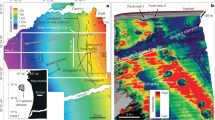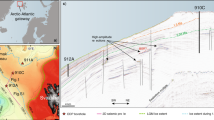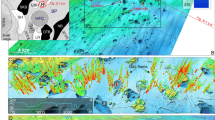Abstract
Palaeoceanographic data have been used to suggest that methane hydrates play a significant role in global climate change. The mechanism by which methane is released during periods of global warming is, however, poorly understood1. In particular, the size and role of the free-gas zone below gas-hydrate provinces remain relatively unconstrained, largely because the base of the free-gas zone is not a phase boundary and has thus defied systematic description. Here we evaluate the possibility that the maximum thickness of an interconnected free-gas zone is mechanically regulated by valving caused by fault slip in overlying sediments2. Our results suggest that a critical gas column exists below most hydrate provinces in basin settings, implying that these provinces are poised for mechanical failure and are therefore highly sensitive to changes in ambient conditions3. We estimate that the global free-gas reservoir may contain from one-sixth to two-thirds of the total methane trapped in hydrate4. If gas accumulations are critically thick along passive continental slopes, we calculate that a 5 °C temperature increase at the sea floor could result in a release of ∼2,000 Gt of methane from the free-gas zone, offering a mechanism for rapid methane release during global warming events.
This is a preview of subscription content, access via your institution
Access options
Subscribe to this journal
Receive 51 print issues and online access
$199.00 per year
only $3.90 per issue
Buy this article
- Purchase on Springer Link
- Instant access to full article PDF
Prices may be subject to local taxes which are calculated during checkout



Similar content being viewed by others
References
Dickens, G. R. The potential volume of oceanic methane hydrates with variable external conditions. Org. Geochem. 32, 1179–1193 (2001)
Finkbeiner, T., Zoback, M., Flemings, P. & Stump, B. Stress, pore pressure, and dynamically constrained hydrocarbon columns in the South Eugene Island field, northern Gulf of Mexico. Bull. Am. Assoc. Petrol. Geol. 85, 1007–1031 (2001)
Flemings, P., Liu, X. & Winters, W. J. Critical pressure and multiphase flow in Blake Ridge gas hydrates. Geology 31, 1057–1060 (2003)
Milkov, A. V. Global estimates of hydrate-bound gas in marine sediments: How much is really out there? Earth Sci. Rev. (in the press)
Dickens, G. R., O'Neil, J. R., Rea, D. K. & Owen, R. M. Dissociation of oceanic methane hydrate as a cause of the carbon isotope excursion at the end of the Paleocene. Paleoceanography 10, 965–971 (1995)
Katz, M. E., Pak, D. K., Dickens, G. R. & Miller, K. G. The source and fate of massive carbon input during the latest Paleocene Thermal Maximum. Science 286, 1531–1533 (1999)
Gorman, A. R. et al. Migration of methane gas through the hydrate stability zone in a low-flux hydrate province. Geology 30, 327–330 (2002)
Tryon, M. D., Brown, K. M. & Torres, M. E. Fluid and chemical flux in and out of sediments hosting methane hydrate deposits on Hydrate Ridge, OR, II: Hydrological processes. Earth Planet. Sci. Lett. 201, 541–557 (2002)
Holbrook, W. S., Hoskins, H., Wood, W. T., Stephen, R. A. & Lizzarralde, D. Methane gas-hydrate and free gas on the Blake Ridge from vertical seismic profiling. Science 273, 1840–1843 (1996)
Engelder, T. & Fischer, M. P. Influence of poroelastic behavior on the magnitude of minimum horizontal stress, Sh, in overpressured parts of sedimentary basins. Geology 22, 949–952 (1994)
Helgerud, M. B., Dvorkin, J. & Nur, A. Elastic-wave velocity in marine sediments with gas hydrates: Effective medium modeling. Geophys. Res. Lett. 26, 2021–2024 (1999)
Miller, A. T. (ed.) Proc ODP Init. Rep. Leg 164, 179–198, (1996)
Guerin, G., Goldberg, D. & Meltser, A. Characterization of in situ elastic properties of gas hydrate-bearing sediments on the Blake Ridge. J. Geophys. Res. 104, 17781–17795 (1999)
Hamilton, E. L. Vp/Vs and Poisson's ratios in marine sediments and rocks. J. Acoust. Soc. Am. 66, 1093–1101 (1979)
Mattar, L. & Brar, G. S. Compressibility of natural gases. J. Can. Petrol. Technol. 14, 77–80 (1975)
Bangs, N. L. B., Sawyer, D. S. & Golovchenko, X. Free gas at the base of the gas hydrate zone in the vicinity of the Chile triple junction. Geology 21, 905–908 (1993)
Hyndman, R. D., Spence, G. D., Chapman, R., Riedel, M. & Edwards, R. N. in Natural Gas Hydrates: Occurrence, Distribution, and Detection (eds Paul, C. K. & Dillon, W. P.) 273–295 (American Geophysical Union, Washington DC, 2001)
Minshull, T. A., Singh, S. C. & Westbrook, G. K. Seismic velocity structure at a gas hydrate reflector, offshore western Columbia, from full waveform inversion. J. Geophys. Res. 99, 4715–4734 (1994)
Hovland, M., Gallagher, J. W., Clennell, M. B. & Lekvam, K. Gas hydrate and free gas volumes in marine sediments: Example from the Niger Delta front. Mar. Petrol. Geol. 14, 245–255 (1997)
Minshull, T. & White, R. Sediment compaction and fluid migration in the Makran accretionary prism. J. Geophys. Res. 94, 7387–7402 (1989)
Pecher, I. A., Minshull, T. A., Singh, S. C. & von Huene, R. Velocity structure of a bottom simulating reflector offshore Peru: Results from full waveform inversion. Earth Planet. Sci. Lett. 139, 459–469 (1996)
Tinivella, U., Lodolo, E., Camerlenghi, A. & Boehm, G. in Gas Hydrates: Relevance to World Margin Stability and Climate Chance (eds Henriet, J. P. & Mienert, J.) 141–151 (The Geological Society, London, 1998)
Kvenvolden, K. A. Gas hydrates–geological perspective and global change. Rev. Geophys. 31, 173–187 (1993)
Paull, C. K., Buelow, W. J., Bussler, W. III & Borowski, W. S. Increased continental-margin slumping frequency during sea-level lowstands above gas hydrate-bearing sediments. Geology 24, 143–146 (1996)
Andreassen, K., Hogstad, K. & Berteussen, K. A. Gas hydrate in the southern Barents Sea, indicated by a shallow seismic anomaly. First Break 8, 237–245 (1990)
Mienert, J., Andreassen, K., Posewang, J. & Lukas, D. in Gas Hydrates: Challenges for the Future (eds Holder, G. D. & Bishnoi, P. R.) 200–210 (New York Academy of Sciences, New York, 2000)
Scholl, D. W. & Hart, P. E. The future of energy gases. Prof. Pap. US Geol. Surv. 1570, 331–351 (1993)
Andreassen, K., Hart, P. E. & Grantz, A. Seismic studies of a bottom simulating reflection related to gas hydrate beneath the continental margin of the Beaufort Sea. J. Geophys. Res. 100, 12659–12673 (1995)
Sain, K., Minshull, T. A., Singh, S. C. & Hobbs, R. W. Evidence for a thick free gas layer beneath the bottom simulating reflector in the Makran accretionary prism. Mar. Geol. 164, 3–12 (2000)
Grevemeyer, I., Rosenberger, A. & Villinger, H. Natural gas hydrates on the continental slope off Pakistan: constraints from seismic techniques. Geophys. J. Int. 140, 295–310 (2000)
White, R. S. Gas hydrate layers trapping free gas in the Gulf of Oman. Earth Planet. Sci. Lett. 42, 114–120 (1979)
White, R. S. Seismic bright spots in the Gulf of Oman. Earth Planet. Sci. Lett. 37, 29–37 (1977)
Acknowledgements
We thank J. Dickens, P. Flemings and A. Milkov for discussions. This work was funded jointly by the US National Science Foundation and the US Department of Energy.
Author information
Authors and Affiliations
Corresponding author
Ethics declarations
Competing interests
The authors declare that they have no competing financial interests.
Rights and permissions
About this article
Cite this article
Hornbach, M., Saffer, D. & Steven Holbrook, W. Critically pressured free-gas reservoirs below gas-hydrate provinces. Nature 427, 142–144 (2004). https://doi.org/10.1038/nature02172
Received:
Accepted:
Issue Date:
DOI: https://doi.org/10.1038/nature02172
This article is cited by
-
Long-distance migration and venting of methane from the base of the hydrate stability zone
Nature Geoscience (2024)
-
Submarine slope failures due to gas hydrate dissociation and degassing along the edge of gas hydrate stability zone in the Krishna Godavari basin
Natural Hazards (2024)
-
Contribution of Deep Hydrocarbons in Gas Hydrate Formation
Chemistry and Technology of Fuels and Oils (2023)
-
Gas hydrate/free gas migration pathways in submarine slope failures: East Indian Margin
Journal of Earth System Science (2021)
-
Investigating the role of faults in fluid migration and gas hydrate formation along the southern Hikurangi Margin, New Zealand
Marine Geophysical Research (2020)
Comments
By submitting a comment you agree to abide by our Terms and Community Guidelines. If you find something abusive or that does not comply with our terms or guidelines please flag it as inappropriate.



